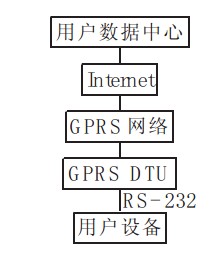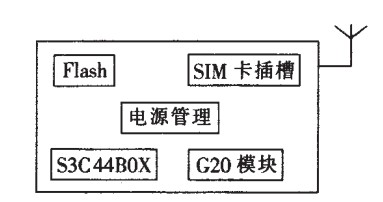Abstract: General Packet Radio Service (GPRS) is a wireless packet switching technology based on the global system for mobile communications (GSM). It provides end-to-end, wide area wireless IP connection and is always online. This paper introduces the data terminal unit (DTU) based on GPRS network. The unit is composed of hardware and software with ARM chip S3C44B0X and GPRS module G20 as the core. On the basis of summarizing the composition of industrial GPRS monitoring system, this paper introduces the hardware design of GPRS DTU. GPRS DTU software is composed of μ C / OS II operating system, TCP / IP protocol and point-to-point protocol. The unit enables users to realize data transmission between user equipment and user data center through GPRS network.
introduction
It is one of the mobile packet service technologies proposed by GSM general (GPRS) in the UK in 1993, and it is one of the first generation of mobile packet service based on GSM, Provide users with IP or X.25 connection of mobile packets. GPRS superimposes a new network on the existing GSM network, adds hardware equipment and software upgrade on the network, and forms a new network logic entity, which provides end-to-end and wide area wireless IP connection, which makes it possible to build a low-cost wireless wide area industrial monitoring network. GPRS data terminal unit (GPRS DTU) does not need the support of background computer. It makes full use of the characteristics of GPRS network "always online, fast access speed and data flow billing". It has incomparable cost performance advantages. It is especially suitable for remote data transmission applications in power system automation, industrial monitoring, environmental monitoring, traffic management and other industries.
1. Composition of industrial GPRS monitoring system
The user equipment is connected with GPRS DTU through RS-232 to transmit data to DTU. After entering the DTU, the data is encapsulated into a data packet suitable for network communication by the GPRS module, sent to the GPRS network, then transmitted on the Internet through the GPRS network, and finally read by the user data center with the specified IP address. The composition of industrial GPRS monitoring system is shown in Figure 1.

2. Hardware design
In this system, the hardware chips used by GPRS DTU mainly include ARM chip S3C44B0X and GPRS communication of Motorola Module G 2 0. S3c 44 b0x is a 16 / 32-bit RISC processor (66 MHz) launched by Sam Sun company. It includes thumb code compressor, an on-chip ice power-off debugging support and a 32-bit hardware multiplier.
In this application, the ARM chip realizes the data communication with GPRS module (UART communication mode or USB communication mode can be adopted), controls the work of data signal acquisition equipment, controls the indicator light, etc. G20 is a new embedded GSM module, which adopts the most advanced technology to meet the data and voice communication market. The main features of G20 include: TCP / IP protocol stack, GSM band egsm900 / 1800 MHz, gsm850 / 1900 MHz, GPRS time slot class 8, Mo / mt SMS, fax, STK function through serial port, RS - 232 / USB interface, wide temperature working range, etc. The hardware structure of G20 includes main controller, receiving module and transmitting module communicating with GPRS network, storage device, power management and audio management module, interface module, etc. G20 realizes data exchange with external circuits through 70 pin interface module. Among them, it mainly includes UART communication interface, USB communication interface and SPI bus interface to realize data exchange with SIM card and audio signal input / output interface. The structure diagram of GPRS DTU is shown in Figure 2.

3. Software design
The software of GPRS DTU is composed of operating system, TCP / IP protocol, point-to-point protocol (PPP), etc.
3.1 operating system
Operating system adopts μ C / OS II, which is a preemptive multitasking micro kernel RTOS with open source code, is characterized by open source code, clear code structure, detailed comments, organized organization, good portability, reducible and curable. The kernel is preemptive and can manage up to 60 tasks.

3.2 TCP / IP protocol
TCP / IP communication protocol consists of transmission control communication protocol (TCP) and Internet communication protocol (IP). The TCP / IP model is shown in Figure 3. The transmission layer of industrial control adopts TCP protocol instead of UDP protocol, because the transmission volume in the real-time monitoring system is small and the reliability requirement is high. TCP protocol is an object-oriented communication protocol. Its main purpose is to provide data transmission and ensure its transmission without error. It has the functions of error detection, data recovery and data retransmission. Before transmitting data, TCP will first establish a communication link between hosts (such as server and client). Through this communication link, data can be transmitted between computers.
LwIP (light weight IP) is adopted in this design. It is a set of open source TCP / IP protocol stack for embedded systems developed by Adam dunkels of the Swiss Academy of computer sciences. LwIP has the following characteristics: it supports IP forwarding under multiple network interfaces, supports ICMP Protocol, including experimental extended UDP, blocking control, round-trip time (RTT) estimation, fast recovery and fast forwarding TCP, provides special internal callback function to improve application performance, optional Berkeley API interface, etc. LwIP can be run in a single thread, that is, there is only one TCPIP thread, which is responsible for handling all TCP connections, and all kinds of network programs pass through
TCPIP thread interacts with the network. However, LwIP can also run multi-threaded to improve efficiency and reduce programming complexity. You can use the following
Function to create a new thread:
void sys_ thread_ new ( void ( *thread ) ( void*arg) ,
void*arg) ;
stay μ In C / OS II, there is no concept of thread, only task. It has provided the system API for creating new tasks and called ostaskcreate, so just encapsulate ostaskcreate
Next, you can implement sys_ thread_ new。 There is no thread in LwIP μ The concept of priority in C / OS II needs to be allocated by the thread created by the user for LwIP in advance
Good priority.
Part of the code for creating a new process related to TCP / IP
As follows:
# define LwIP_ STK_ SIZE 10*1024
# define LwIP_ TASK_ MAX 5
# define LwIP_ START_ PRIO 5
OS_ STK LwIP_ TASK_ STK[ LwIP_TASK_MAX]
[ LwIP_STK_SIZE ] ;
u8_ t curr_ prio_ offset ; sys_ thread_ t ; sys_ systhread_ new ( void ( *function ) ( void*arg ) ,void*arg, int prio)
3.3 PPP agreement
PPP provides a standard method for the transmission of multi protocol self addressed packets based on point-to-point connection. PPP was originally designed to provide an encapsulation protocol for IP traffic and transmission between two peer-to-peer structures. In the TCP / IP protocol set, it is a data link layer protocol for synchronous modulation connection (layer 2 in OSI mode of development system interconnection reference model). PPP mainly creates the connection of telephone lines and dial-up access network service providers (ISPs) of Integrated Services Digital Network (ISDN). It has a variety of functions such as authentication methods, data compression and encryption and notification of IP address. The data to be transmitted is encapsulated into TCP packets according to the TCP format, plus the IP header and tail into IP packets, and then encapsulated into PPP frames according to the PPP frame format. Finally, it can be used for transmission. To establish a connection with the Internet, DTU must first attach to GPRS network, and then initiate the context activation process of packet data protocol (PDP), so as to establish a logical path with GPRS support node (GGSN) and establish a connection with the Internet.
3.4 procedure flow
After the system is powered on, first initialize the hardware, then initialize the operating system, then configure the system file, create tasks, initialize the network (TCP / IP, PPP), and start multi task scheduling. Send LCP packets through PPP to set and test the data link and link with G20 module; Then password authentication protocol (Pap) authentication is performed; After passing, PPP sends NCP packets, selects and sets a network layer to run IP protocol. Once the protocol is set, GPRS DTU can be connected to the Internet. DTU initiates a connection to the IP address of the user data center and requests registration, and then it can start to interact with the user data center to control instructions and data.
4. Conclusion
The purpose of researching and designing GPRS DTU is to apply it to the oily sewage remote monitoring system of Wuhan University of technology. The test effect in the current experimental stage proves the feasibility of this scheme. Compared with the traditional remote monitoring system based on wired connection or GSM short message, the remote monitoring system based on GPRS has many advantages, such as short connection time, strong real-time performance, always online, reasonable charge, low price, etc. it is believed that GPRS DTU will also have a good market prospect.

 Manager Wang
Manager Wang
 OfficialAccounts
OfficialAccounts